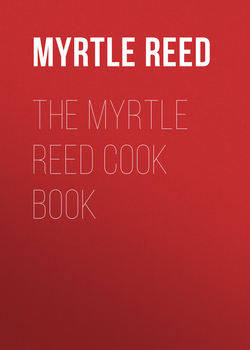Читать книгу The Myrtle Reed Cook Book - Reed Myrtle - Страница 13
RAISED BREAKFAST BREADS
ОглавлениеAlthough many recipes included in this section may seem, at first glance, to be unsuitable for breakfast on account of the length of time taken for rising, there are ways in which the time can be considerably shortened.
A competent authority says that any mixture for rolls or muffins can be made ready for its second rising at night, and kept over night in any place where the dough will not freeze, or where the temperature is not so high as to cause too rapid rising and consequent souring of the dough.
Moreover, rolls or muffins may be baked in the afternoon until done thoroughly, but not brown, wrapped in a cloth, and put away in a cool place. In the morning, they need only to be rubbed with melted butter and set into a hot oven for a very few moments. They will come out crisp and flaky, and free from all objections on the score of indigestibility. Bread twice baked is always much more digestible than fresh bread.
Brioche, the most delicious of all hot breads, needs to stand in the refrigerator over night, and the second process is a quick one when the paste is once made. The paste will keep a week or more in a very cold place, and be the better for it. It is a French dough, for which many complicated recipes are given, but the following will be found satisfactory, and not difficult after one or two trials.
BRIOCHE PASTE
One cake of compressed yeast, a pinch of salt, one and one fourth cupfuls of butter, four cupfuls of flour, one tablespoonful of sugar, two tablespoonfuls of warm water, and seven eggs. Dissolve the yeast in the water, adding a little more water if necessary, and rubbing the yeast cake with a spoon until thoroughly dissolved. Stir in enough sifted flour to make a stiff dough, rolling and patting with the hands until thoroughly mixed. Drop this ball of paste into a kettle of warm water and let stand in a moderate temperature until it has a little more than doubled in bulk. (Some recipes for Brioche say that the ball of paste should be light enough to float.) Put the remainder of the four cupfuls of flour into a mixing bowl, add the sugar, salt, and butter, softened but not melted, and four of the eggs, unbeaten. With the hand mix carefully to a paste, beat smooth, and add the rest of the eggs, unbeaten, one at a time. Take the ball of paste, when light, out of the warm water with a skimmer, and, still using the hand, incorporate it carefully with the egg mixture, folding the two together as lightly as possible. Let rise, in a moderate temperature, until double in bulk. Then turn the paste on a floured board and pat and fold with the hands until smooth in texture and inclined to stay in shape. Let rise once more until very light, then put into the refrigerator and let stand over night.
BRIOCHE ROLLS
Roll a large lump of Brioche dough into a thin sheet on a floured board or pastry slab, working lightly and quickly, spread with softened butter, and fold so that the paste will be in three layers. Cut in strips an inch wide and twist, working from the ends, and arrange in circles on a baking-sheet, the ends of the strips pointing inward. The rolls should be very close together in the pan. Beat the yolk of an egg, dilute it with as much milk, and brush the rolls with the mixture. Let them rise a few minutes, then bake about half an hour in a moderate oven. A little sugar and water may be spread over the tops if desired.
